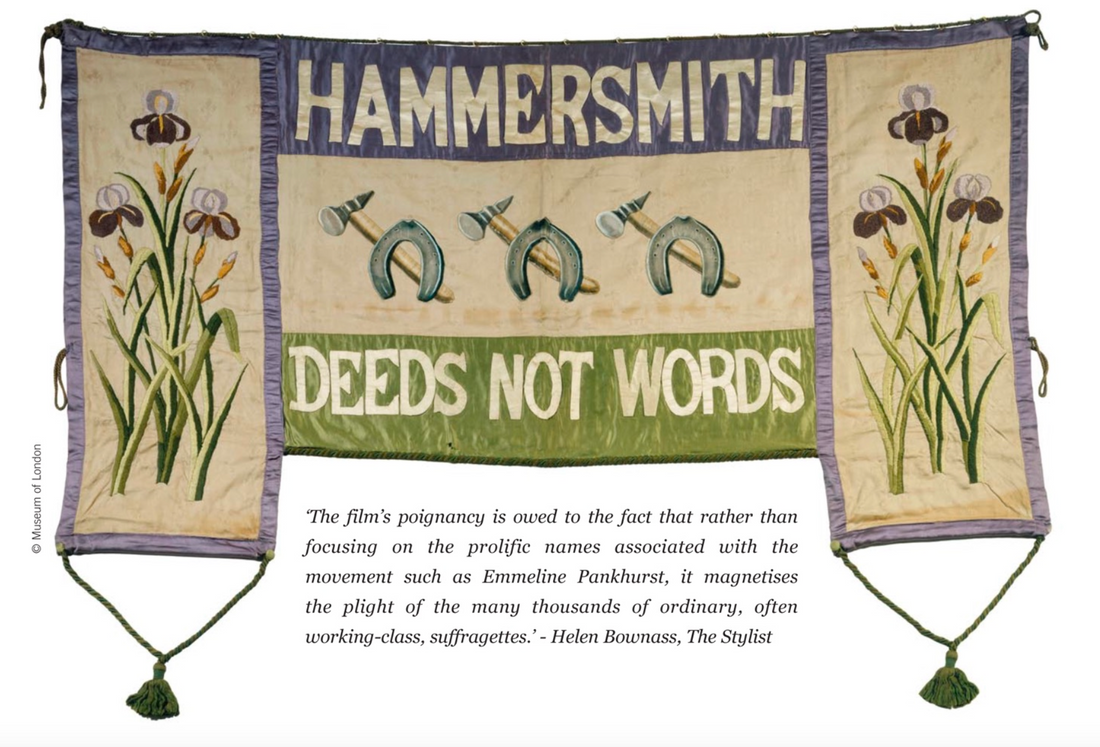
Soldiers in Petticoats
Released in October 2015, Suffragette stars Meryl Streep as the figurehead of the fight for women’s right to vote, Emmeline Pankhurst, and also Carey Mulligan and Helena Bonham Carter as other prominent activists. Of interest to many viewers will be the depiction of contemporary costume, and in the film Streep as Pankhurst is shown dressed in subdued, respectable clothing accessorised with a silver medal complete with ribbon in the Suffragette colours of green, purple and white.
Although for some the word ‘suffragette’ might bring to mind images of Edwardian, middle class ladies chained to railings, or the horrific, grainy pictures of Emily Wilding Davison suffering fatal injuries from the King’s horse at the 1913 Derby, this resistance movement also operated as a sophisticated political organisation. Actually called by its members the ‘Women’s Social and Political Union’, who were themselves dubbed ‘Suffragettes’ by the Daily Mail, this organisation chose its colours as a means to covertly, and also overtly, indicate solidarity. The colours, which were chosen to represent dignity and freedom (purple), purity in public and private life (white) and hope and newness (green), created a sense of unity, which was something that many women of the time had not yet experienced.

Image: Carey Mulligan as Maud Watts in Suffragette directed by Sarah Gavron 2015. Image above: Suffragette banner of the Hammersmith branch of the militant Women's Social and Political Union.
Expression of this new commonality amongst women appeared in the form of textile crafts and is particularly visible in the embroidered, stencilled and appliquéd banners that identified ‘chapters’ of the Women’s Social and Political Union. The banners were used to promote The Causein processions and marches, or used as templates for printed leaflets. The collaboratively produced banners would carry beautifully crafted slogans such as ‘Votes for Women’, ‘Believe and You Will Conquer’ and the notorious call for violent protest – ‘Deeds, not Words’. Some banners were even woven and there are some intriguing examples of these held in the Women’s Library at the London School of Economics (LSE) Suffragette banner collection.
Although for some the word ‘suffragette’ might bring to mind images of Edwardian, middle class ladies chained to railings, or the horrific, grainy pictures of Emily Wilding Davison suffering fatal injuries from the King’s horse at the 1913 Derby, this resistance movement also operated as a sophisticated political organisation. Actually called by its members the ‘Women’s Social and Political Union’, who were themselves dubbed ‘Suffragettes’ by the Daily Mail, this organisation chose its colours as a means to covertly, and also overtly, indicate solidarity. The colours, which were chosen to represent dignity and freedom (purple), purity in public and private life (white) and hope and newness (green), created a sense of unity, which was something that many women of the time had not yet experienced.

Image: Carey Mulligan as Maud Watts in Suffragette directed by Sarah Gavron 2015. Image above: Suffragette banner of the Hammersmith branch of the militant Women's Social and Political Union.
Expression of this new commonality amongst women appeared in the form of textile crafts and is particularly visible in the embroidered, stencilled and appliquéd banners that identified ‘chapters’ of the Women’s Social and Political Union. The banners were used to promote The Causein processions and marches, or used as templates for printed leaflets. The collaboratively produced banners would carry beautifully crafted slogans such as ‘Votes for Women’, ‘Believe and You Will Conquer’ and the notorious call for violent protest – ‘Deeds, not Words’. Some banners were even woven and there are some intriguing examples of these held in the Women’s Library at the London School of Economics (LSE) Suffragette banner collection.
Want to read more of this article?
We are proud to be a subscriber-funded publication with members in 185 countries. We know our readership is passionate about textiles, so we invite you to help us preserve and promote the stories, memories, and histories that fabric holds. Your support allows us to publish our magazine, and also ‘what's on’ information, and subscription interviews, reviews, and long-read articles in our online blog.
ALREADY A SUBSCRIBER? CLICK HERE TO ACCESS CONTENT

